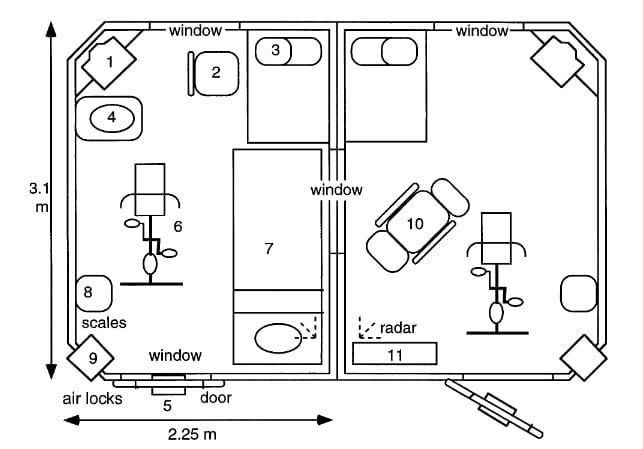Room indirect calorimeters from Maastricht University exhibit high performance and impressive repeatability.
Room indirect calorimeters, also known as respiration chambers, have been operational for over 30 years and form part of the Metabolic Research Unit Maastricht (MRUM). A study by Schoffelen et al. characterized these room indirect calorimeters with fully automated calibration and assessed its performance. Validation of the system was also conducted. This article characterises the components of the room indirect calorimeters by detailing the room environment, ventilation and gas measurement systems and its performance.
An upcoming second article will further describe the validation of the whole system.
Room calorimeter
Subject Environment
Designed to look like a normal room, these 14m3 chambers (Fig. 1) with windows are well-furnished to provide a friendly environment for the subjects, with the possibility of social contact during the experiment.
Fig. 1. Layout of dual respiration chamber. 1, Television set; 2, chair; 3, sink with hot and cold running water; 4, deep-freeze toilet; 5, air lock for blood samples; 6, cycle ergometer; 7, bed (folded down for sleeping or sitting); 8, body-weight balance; 9, air locks, one for food, one for feces; 10, folding chair, which may be stored under bed; 11, bed (folded up for more floor space).
Three airlocks provide passage for sampling of blood (Fig. 1-5), delivery of food and collection of wastes (Fig. 1-9). Physical activity can be performed using a cycle ergometer (Fig. 1-6) or a treadmill. Activity of the subject can be measured using an analogue ultrasound radar system.
Ventilation
The negative pressure (pull type) system draws fresh air from outside the building which is routed directly into the air-conditioning for mixing and temperature control before passing it into the chambers. Such a system ensures that airflow through leaks will only be from outside to inside the chamber. With the well-ventilated room surrounding the chamber (rate of five times its volume per hour), this has a negligible effect on measurements.
Flow is measured using electronically modified dry gas meters. The recirculation flow range of ventilating the 14m3 volume at a rate of 15–42 times per hour calculates to a mixing time constant of 1.4–4.2 min, comparable to room calorimeters from other studies. At the lowest recirculation flow rate, the system was capable of measuring 99% of a 5 min continuous injection of gas within 15 min.
O2 and CO2 Measurement System
Key elements in the gas-analysis system are the sampling system and the gas analyzers.
The system consists of dual pairs of paramagnetic O2 analyzers and infrared CO2 analyzers that measure each gas sample in duplicate, hence improving reliability of measurements. O2 analyzers have superior repeatability. When tested with identical gas samples over the 0–18% O2 concentration range, measurements were within 0.002% standard deviation. Frequent automated calibration is a unique feature of the system, correcting for analyzer drift and barometric pressure variations. Daily calculation of O2 concentration of calibration gas over the 3 months lifespan of a calibration gas bottle showed excellent reproducibility (standard deviation = 0.004%), and high capability of handling environmental variation and drift. Therefore, variations in ambient temperature and pressure have little effect because of the unique automated calibration method.
Another advantage of this feature is its exceptional ease of use; to start an experiment, one has only to close the door of the chamber.
Calculations of VO2 and VCO2 are provided at 0.5h intervals and are determined from the difference in gas composition between incoming and outgoing air and the ratio of gas composition to the difference in time in the chamber (derived from measurement of the outgoing air). From these VO2 and VCO2 calculations, energy expenditure is derived with the Weir formula.
Conclusion
The room calorimeters from Maastricht University provides a friendly environment for test subjects and has exceptional ease of use and low risk of operating errors. With its intermittent calibration, stable performance is achieved and can effectively be used 24-hours/day; 7-days/wk. Each room is equipped with state of the art climate control technology in order to provide customisation of environmental conditions (temperature, pressure and humidity) tuned for specific research experiments. The gas measurement system comprises innovative gas sampling, gas analysis techniques and automated sensor calibrations providing the most accurate results achievable.
Contact us to find out more about indirect calorimetry and our instruments.

